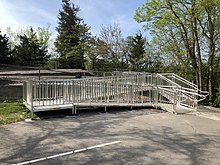Accessibility

Accessibility is equal access for people with disabilities to any environment, movement, information or communication. It means that a person with a disability should be able to use a product or service to access society at the same level as a person without a disability.
Examples of accessibility include:
- Buildings that have access ramps for people in wheelchairs or motorised scooters
- Close captioning on television and subtitles on DVDs for people who cannot hear
- Sign language that allows deaf people to communicate other people
- Braille for people with a vision impairment to help them read books
- Modified computer software and hardware that allows people with a disability or disabilities to access the Internet and use a personal computer
The word accessibility is used in the Convention on the Rights of Persons with Disabilities, mostly in article 9.
Having accessible ramps and parking is very important for the people who struggle with disabilities.

